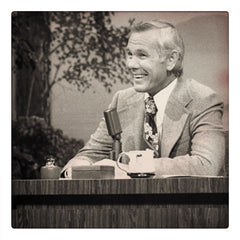Behind the Late Night Desk

You know a talk show means serious business if they put the host behind a desk.
Talk shows use their sets to communicate subtle hints about their content. The soft armchair of a daytime show like Oprah tells you that it’s going to be intimate and confessional. The stools of the Today Show or Live with Kelly and Michael recall a breakfast nook and clever quips over bacon. But the desk of a late night talk show means that show business is serious business.
And it is, of course. Appearing on a late night talk show significantly boosts awareness of a performer’s projects, so actors and musicians are sent out on rounds of shows when they’ve got a new album or an upcoming film to plug. And talk show appearances can also help smooth over public relations gaffes and get back in an audience’s good graces. Talk shows are naturally aware of this value to studios and performers and wield this power proudly from behind their wood laminate throne – the desk.
Though he wasn’t the first in late night, there’s no question that Johnny Carson was the King. He had five desks over the course of his thirty-year run – one of which sold for $38,000 at auction in 2005. Like most late night hosts, Carson’s desk was positioned to be shown on the right side of the TV screen. One reason for this may be that since Western audiences read from left to right, our eyes stay on that side of the screen. So placing the host on the right side of the screen makes them seem powerful.
Having the host behind a desk makes me think that the desk is somehow an attempt to make it seem like a normal job. Of course, Talk Show Host is technically a job and this is their workplace, but it’s pretty far from the 9 to 5 that the rest of us experience.
I like to think that the host might work there all day, not just when the cameras roll – crafting the monolog, writing interview questions, jotting down memos to the staff about upcoming guests. I like to imagine that if we were to rifle through the drawers (if indeed there are any drawers), we’d find the same thing that everyone has in their desk at work: file folders of current projects, a list of everyone’s extensions for the phone network and tons of sticky notes.